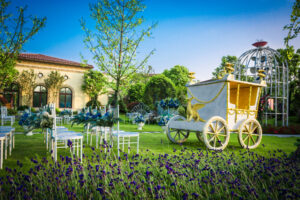 Whether we accept it or simply choose to ignore it, we are all familiar with the effects of ageing. An old car needs new parts, an ageing house requires updates, and similarly, a landscape that has been in place for several years requires special attention. In today’s blog post, Account Manager Coltin Vaughn provides a helpful guide to managing the effects of time on your property.
Whether we accept it or simply choose to ignore it, we are all familiar with the effects of ageing. An old car needs new parts, an ageing house requires updates, and similarly, a landscape that has been in place for several years requires special attention. In today’s blog post, Account Manager Coltin Vaughn provides a helpful guide to managing the effects of time on your property.
The first obvious question is, “When does my property need this type of attention?” When a landscape reaches 10-15 years old, it’s time for some updates. The good news is that you don’t have to start from scratch. Follow the steps below, and you’ll be well on your way to a landscape that looks like new!
Replace Or Add Plants.
Start by noticing what has changed in your landscape. Have some plants gotten too big? Does any look unhealthy? Keep an eye out for sparse leaves and dead branches. Many overgrown plants can be easily pruned, while those with signs of an unhealthy root system should be replaced. Also, keep in mind that some plants do not do well with aggressive pruning. If you have overgrown juniper or evergreen trees, for example, removal is the best option. Once you have inspected the quality of the current plant material, consider whether anything needs to be added. Adding flowering perennials or annuals can provide vibrant colour to your property, giving it a more welcoming appearance.
Replace Or Add Other Accessories.
Take a moment to inspect any other accessories on your property, including benches, planters, hanging baskets, steps, lighting and fountains. Make sure everything is in working order, and be careful to notice anything broken or showing obvious signs of ageing, such as peeling paint or missing parts. Replace items as necessary.
Reevaluate Sunlight
Are trees providing more shade than 10 years ago? What once had plenty of sun to thrive may now be struggling to get the right amount of sunlight to grow. If increased shade is hindering a plant’s growth, replace it with something more shade-tolerant. Often, increasing shade will thin out an area of grass, leaving bare dirt instead of lush grass. In this situation, simply spreading your bedding space with pine straw or pine bark mulch will solve the problem without breaking the bank.
Consider How Your Needs Have Evolved.
Think about what you currently need from your property. As your landscape changes, so does your family or business. Where you once needed a swing set, you may now prefer a seating area or additional plants. Perhaps your property now receives high foot traffic due to surrounding developments. Consider how your property can best serve your business or family in this new season.
 Home and Garden Landscaping Ideas for Modern and Traditional Homes
Home and Garden Landscaping Ideas for Modern and Traditional Homes
Landscaping can dramatically improve the appearance of your home. Landscaping can create an inviting space to relax with the family and enjoy the outdoors. Decorating your front yard can improve the curb appeal and value of your home. When done right, DIY decorating can make your home a more beautiful and useful place.
Natural elements such as land and bodies of water. Foundations are landscapes. All earthworks or other changes to the shape of the land are usually completed before new plants are added or finished. The shape of the earth is generally changing to be more useful or attractive from a human perspective. Changes must take into account environmental elements such as climate and sunlight, as well as wildlife habitat.
Landscaping involves working with the land to make it practical and beautiful. Access is a key factor in the practicality of land. Garden paths are often landscaped with gravel, organic mulch or stones to ensure a long-lasting and aesthetically pleasing surface. User-friendly driveways can be planted with grass or other ground cover plants.
Trees and shrubs serve the purpose of garden landscaping to complement the basic form of the land. They can be used for sun protection and wind protection. They can also provide habitat for beneficial insects and other wildlife. Trees and shrubs can be used together to create a layered landscape that feels welcoming and comfortable.
Landscape design requires skill in horticulture and visual arts. Homeowners and landscape contractors often perform landscape design informally. Formal landscape design takes many different forms, from technical to artistic. Landscape design can be carried out by landscapers, landscape architects, civil engineers, surface geologists, exterior decorators and permaculture designers, among others. Due to its interdisciplinary nature, landscape design is often completed in teams involving different experts.
